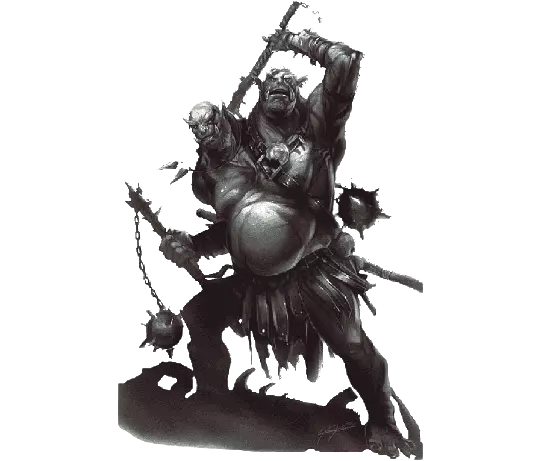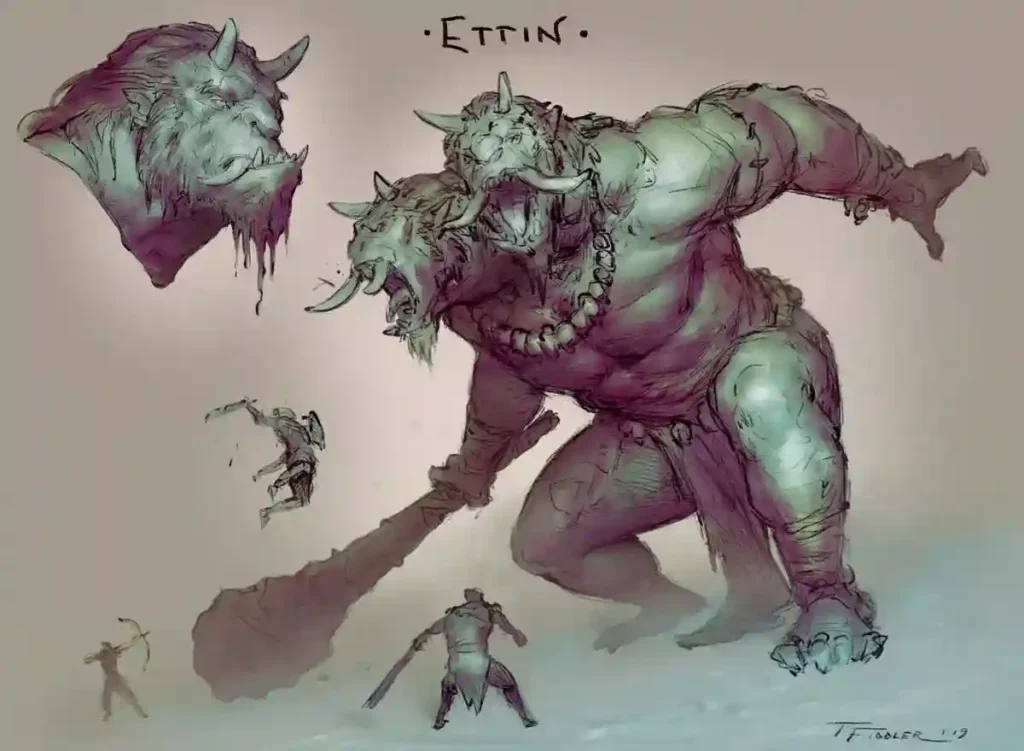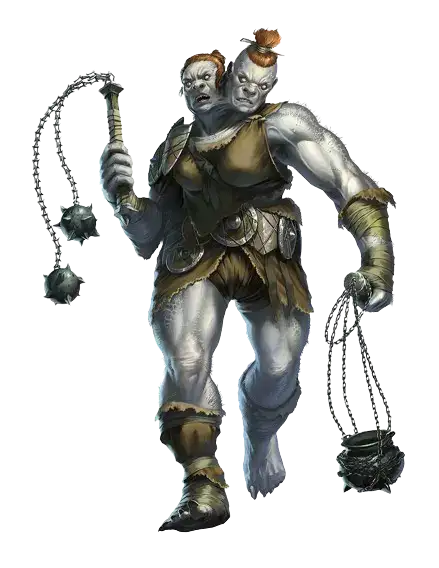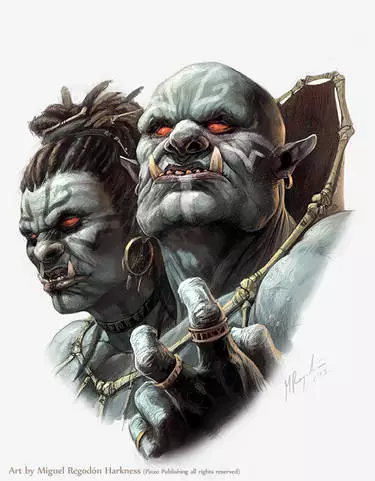Ettin, also known as a bicephalic giant, is a formidable two-headed giant creature in the DnD 5e universe that is characterized by its substantial size, savage nature, and limited intellectual capacity. It is commonly encountered in untamed environments or near malevolent entities.
Description
Ettins, also known as two-headed giants, were the result of conjoined twins among the giant species. These giants were characterized as degenerate brutes, with their names translating to “ugly giant” in ancient Common and “runt” in Jotun.
Upon initial observation, ettins bear a resemblance to comparatively diminutive individuals of other colossal races, standing at approximately 13 feet (4 meters) in height. In addition to having two heads, ettins frequently bore a resemblance to hill or stone giants. However, upon closer scrutiny by scholars and explorers, it is apparent that even hill giants have a higher level of civilization in comparison to ettins.

These giants are massive, with extremely wide shoulders, long arms, and considerable weight.
The reported weight of these creatures varies between approximately 450 kilograms (1,000 pounds) and over 2,300 kilograms. Regardless of their weight, the ground trembled when they moved. Curiously, the individual’s physique exhibited a slight asymmetry, with the right side displaying a slightly greater degree of muscularity and development compared to the left side. However, this disparity is not significant enough to diminish their fierce and savage appearance.
In general, males exhibit greater height and weight compared to females. However, females, in addition to having longer hair, frequently possess a more robust physique in contrast to the relatively lean and slender males.
Threat level & details
An Ettin is a Deadly enemy only for Low-level parties.
- Maximum Player’s Level for Deadly Encounter*: 2
- Minimum Player’s Level for Easy Encounter**: 5
- Party members: 4
- Number of enemies: 1
* Above this level, the Encounter becomes easier
** The starting level from which the encounter becomes easy
Analysis conducted by A.T.L.A.S. Foundation – Research Division
Ettin’s Stat Block
Large giant, chaotic evil
Armor Class 12
Hit Points 85 (10d10+30)
Speed Walk 40ft.
STR 21 (+ 5)
DEX 8 ( -1)
CON 17 (+ 3)
INT 6 ( -2)
WIS 10 (+ 0)
CHA 8 ( -1)
Saving Throws Str + 5, Dex -1, Con + 3, Int -2, Wis + 0, Cha -1
Skills Perception +4,
Senses darkvision 60 ft., passive Perception 14
Languages Giant, Orc
Challenge 4 (1,100 XP)
Two Heads. The ettin has an advantage on Wisdom (Perception) checks and saving throws against being blinded, charmed, deafened, frightened, stunned, and knocked unconscious.
Wakeful. When one of the ettin’s heads is asleep, its other head is awake.
Actions
Multiattack. The ettin makes two attacks: one with its battleaxe and one with its morningstar.
Battleaxe. Melee Weapon Attack: +7 to hit, reach 5 ft., one target. Hit: 14 (2d8 + 5) slashing damage.
Morningstar. Melee Weapon Attack: +7 to hit, reach 5 ft., one target. Hit: 14 (2d8 + 5) piercing damage.
Description – further information
Another distinctive characteristic of this kind of monstrous beings is definitely their ferocious nature and their distinctive lack of hygiene: given the option, ettins refrained from bathing, resulting in their already thick skin being encrusted with a substantial layer of filthy grime, which emitted a repulsive odor and gave them a grayish-brown complexion.
Curiously, this leads many (unfortunate we might say) adventurers to believe that the latter is actually their skin’s color. However, beneath the grime, ettins possess a skin complexion that varies from pink to brownish, accompanied by hands and feet tinged with yellow and adorned with callouses.

The ettin’s thick skin contributes to its Armor Class. The hair of an ettin is characterized by its lengthy, lanky, and disheveled appearance, while its teeth are notably sizable, yellowed, and frequently decayed.
The facial characteristics of the ettin closely resemble those of an orc, including prominent watery eyes, an upturned piggish snout, and a large mouth.
The dominant head of an ettin is invariably the right one, and the right arm and leg are likely to exhibit a slightly greater degree of muscularity and development compared to the left side. An ettin exclusively dons coarse, untreated hides that are soiled and unwashed. Undoubtedly, ettins emit a highly unpleasant odor as a result of their utter disregard for any grooming practices, whether positive or negative.
Disregarding their disinclination to maintain personal hygiene, ettins display a complete disregard for their physical appearance and are devoid of any grooming practices, including those that are considered unfavorable. On top of their unattractive heads, there was a disheveled tangle of long, thin hair, and within their sizable, foul-smelling mouths were misaligned, yellow, and frequently decayed teeth. Ettins exhibit primitive characteristics reminiscent of orcs, such as prominent, watery eyes, pig-like snouts, and shovel-shaped jaws with lower canine teeth that extend outward like boar tusks. These tusks, despite being easily accessible, are equally repugnant in their decayed state, much like the rest of their teeth.
The ettins’ lack of cleanliness is evident also in their attire, which consisted of uncured, unwashed, and scraggly animal skins that were often decaying and infested with moths. The sole purpose for wearing these garments is to serve as a portable cover, providing a soft and warm material for sleeping.
However, it is worth noting that they did possess some understanding of accessories, as evidenced by their practice of using severed heads as adornments and the females’ tendency to wear jewelry as a sign of social standing.
Behavior
Ettins are a belligerent and savage species known for their volatile nature and affinity for dominance. They were innate tyrants who subjugated those who lacked the ability to protect themselves, subjecting the vulnerable to direct suffering and intimidation. Their dual-headed nature, which provided minimal enhancement to their overall cognitive abilities, made attempting to exploit their limited intellect a hazardous endeavor.

Ettins possess a limited notion of worth, preserving items such as corpses as trophies and amassing gems, coins, and art objects for admiration. They also have a fundamental understanding of trade principles but harbor distrust towards all entities, including their own kind: sometimes they engage in negotiations with potential prey to obtain the maximum benefit while minimizing potential risks.
Ettins are cautious and driven by their desire for wealth, but they also possess an understanding of gratitude and are willing to undertake significant risks for individuals who have managed to gain their trust. On rare occasions, certain ettins even exhibit traits of curiosity, imagination, humor, and kindness. They display friendly or non-aggressive behavior, particularly when they have a comfortable lifestyle and abundant food.
Each head of an ettin possesses a unique individuality, personality, memories, preferences, and quirks. The widely recognized depiction of the dual-headed creature engaging in self-debate is of questionable veracity. Some reports indicate that ettins are dissuaded from engaging in serious combat with each other. The right side of an ettin consistently exhibits superior strength, establishing it as the dominant side in the relationship, while the left side consistently assumes a submissive role.
Ettins exhibit some quarreling behavior, but their interactions are more akin to that of unruly siblings being compelled to constantly coexist, rather than bitter enemies. In times of combat, serious disputes are infrequent, as the warring parties manage to set aside their conflicts and engage in actions that are mutually advantageous.
Two heads body: hightened senses and lesser weaknesses
Ettins possess formidable strength and a robust exterior, but their skill set is rather limited, resembling that of enlarged ogres, except for their distinctive feature of having two heads. The presence of multiple heads on an ettin provides it with immunity to spells that manipulate the mind, and they have very limited spellcasting abilities.
The exceptional infravision of an ettin was enhanced by its two heads, providing it with heightened senses. Despite their ability to perceive light without hindrance, ettins harbored a strong aversion towards sunlight and other intense sources of brightness. They are prone to being abandoned in obscure and concealed locations, making it riskier for them during daylight hours. Their olfactory acuity allows them to discern between animals and civilized individuals, unfamiliar and familiar environments, and detect specific details solely through their sense of smell.
Biology theories: What happens to a beheaded Ettin?
According to numerous legends about ettins, it was believed that they possessed the ability to regenerate their severed heads, much like hydras. However, this claim is false.
Nevertheless, it is uncertain whether an ettin is able to survive if it were to lose its head. While it may appear implausible due to the need to sever the jugular vein, it is worth considering that there are reports of other similar creatures, like chimeras, that have demonstrated the ability to survive even after the removal of one of their heads.
According to some reports made by adventurers who were able to sever one of their head, ettins are believed to exhibit a potential instinctive physiological response when their head is severed, redirecting blood vessels and nerves toward the remaining head.
However, if an ettin were to have its head removed and somehow manage to survive, it would suffer a significant disadvantage, as it would lose all the distinctive advantages of having two heads. The removal of the subordinate head results in a complete takeover by the dominant head, while the absence of the dominant head will cause the remaining head to thrash about in a disorderly and uncoordinated manner on the opposite side of the body.
A one-headed Etting will finally acquire complete mastery of their new body in a period of around two-three months following the occurrence. Additionally, a single-headed ettin would be regarded with disdain by others, considering it as being physically abnormal. However, since they already displayed indifference towards each other’s judgments, this drawback would be of little significance.
The relationship between Ettins and their allies
Ettins, who have never had privacy or isolation, aggressively pursue solitude by mercilessly crushing any intruders in their territories, without hesitation or prior notice. Most ettins strongly dislike having to deal with another individual, especially if it is another member of their kind. This is because a loud argument between four aggressive primitives is even more unbearable than their usual state of affairs.
They will only occasionally assemble into small clusters, such as gangs of living companions or bands of roaming destroyers, in the presence of an exceptionally powerful, intelligent, or strong-willed ettin. These groups, consisting of 2-5 individuals, collaborate solely when there is a tangible advantage and as long as the leader remains alive and unbeaten. The demise, departure, or discrediting of the leader, or any significant loss experienced, frequently resulted in the fragmentation of group unity and dissolution of the collective.

Although ettins did not consider currency to be valuable beyond its appearance, they still collected it because other, less significant creatures found it desirable.
However, these animals are typically hazardous and capable of taking care of themselves.
Animals such as bears, including owlbears, and creatures like wyverns have often been observed to coexist with these giants, and they occasionally formed a mutually beneficial relationship with the likewise solitary otyughs.
Ettins are also known to utilize the currency they amassed in order to furnish goblins or orcs with valuable possessions. By employing this strategy, an ettin can not only make others endure its close proximity but also force them to construct a wall or trap or to engage in combat alongside it. Orcs, due to the visual resemblances, regarded the ettins as distant relatives. They entice these creatures into forming unstable alliances by offering them food, treasure, and the prospect of looting in return for their assistance as scouts, raiders, and protectors.
Additionally, they occasionally serve under the authority of more dominant hill, frost, and fire giants.
Language and communication
Ettins typically do not possess a native language and are not particularly proficient in any specific language. Conversely, they communicate using a simplified language that combines elements of goblin, orc, giant, Common, and Abyssal. They also acquire bits of vocabulary and phrases from other cultures, influenced by the prevailing language spoken in their vicinity. Deciphering this convoluted language was not overly challenging for those familiar with its constituent languages. Ettins, likewise, had no trouble understanding each other’s communication, which involved a combination of grunts, growls, throat clearings, and speech.
Ettins were commonly identified by compound names that encompassed the entire entity, while specific parts of those names were used to refer to individual heads. The initial syllable or two denoted the first head, while the latter portion of the name indicated the second head, and both were collectively referred to by the compound name.
Relationships and Reproduction
Among ettins, females held the dominant position and took the lead in initiating their primitive courtship rituals.

Courtship between Ettins
They adorn themselves with spoils acquired from their prey to demonstrate their prowess in hunting, thereby enhancing their appeal to males.
Additionally, they present these items as offerings to males in order to court their affection. Contrary to other humanoid races, in the context of these giants, courtship typically involves a female actively pursuing a male and asserting dominance over him, resulting in the male remaining in close proximity and providing care for the female.
Considering the fact that the heads of an ettin were connected to the same lower body, it isexpected that they would have the same gender.
Reproduction Cycle
The gestation period of a female ettin lasts approximately 6-7 months. After giving birth, the subjugated male was allowed to depart, although, despite their limited capacity for mutual tolerance, the males generally remained in proximity until the offspring achieved self-reliance.
An ettin child reaches a height of approximately 5 ft (1.5 m) and develops some self-defense skills within six months of birth. They can be considered fully mature between eight months to a year. At this stage of development, the young individuals possessed the ability to independently engage in hunting. Subsequently, the parents would either expel the young adult to survive on its own, resulting in the abandonment of the den they are utilizing, or, if the ettins were part of a collective, the young adult will be regarded as a regular member of the group.
Ettin’s Religion and Spiritualism
Ettin shamans communicates with spirits, cast curses, and motivated their kin with fierce chants, rendering their adversaries susceptible to assault while bolstering and inciting their comrades to annihilate them.
Strategies – How Ettins fight their enemies
Ettins demonstrates their perilous nature as adversaries, exhibiting unexpected displays of cohesion during battles, leveraging the advantages of their dual heads beyond initial expectations. Due to the presence of two heads, ettins exhibited a heightened locomotive capacity, enabling their bodies to move at twice the speed of a comparable creature with a single head. Moreover, the independent functioning of their left and right arms is unhindered. In addition to their large size and lack of intelligence, the long-armed ettins possess the ability to easily attack smaller adversaries such as gnomes, thanks to their constant vigilance from one of their heads.
Despite their inclination to initiate attacks immediately upon encountering their adversaries and persistently fighting until all enemies are eliminated, they are not prone to recklessness. They are willing to retreat when victory appears unattainable and avoid engaging in combat with significantly more powerful opponents when escape is a viable option. Certain highly intelligent ettins were capable of acquiring spellcasting abilities, either as bards or shamans. With appropriate training, one head could cast spells while the other engaged in physical combat, demonstrating equal proficiency in both spellcasting and weapon wielding.
Fortunately, except for themselves, ettins typically lack the intellectual capacity to fully exploit their strengths, although their lack of intelligence was offset by their rudimentary cleverness and basic understanding of tactics. Ettins are adept at ambushing their prey, preferring to overpower vulnerable targets rather than engage in direct combat. They excel in delivering short but powerful bursts of strength, rather than engaging in prolonged hand-to-hand combat. They engage in nocturnal hunting to exploit their heightened senses and evade potential attacks from diurnal opponents, displaying no concept of honor or truces in battle.
Although ettins possess ruthlessness, they can be effectively dealt with if confronted by a skilled group of warriors equipped with adequate weapons. The inherent immorality of these creatures made it possible to entice the more vicious ettins into traps by exploiting their susceptibility to the terrified screams of potential prey. If the heads are positioned in opposition to one another, an ettin can become its own most formidable adversary as it overtly endeavors to control and pummel itself into surrender. The two-headed giants lacked both the ability and the inclination for finesse, as evidenced by the wreckage and disturbed soil that remained after their clumsy and destructive attacks.
The creatures emit primal and wet cries of agony and exasperation when they are skillfully avoided by agile adversaries, and when surrounded from all sides, they resort to forcefully swiping away the bothersome intruders.
Environment – Forgotten Realms
What is the Forgotten Realms? Forgotten Realms is a realm characterized by unfamiliar territories, perilous creatures, and powerful gods, where magic and supernatural occurrences are undeniably present. It is believed that in the distant past, there was a stronger connection between planet Earth and the realm known as the Forgotten Realms. Over time, the Earth’s inhabitants had largely lost awareness of the existence of the other world, which is why it came to be known as the Forgotten Realms.
Ettin Shamans served as a connection between true giants and giant-kin, being classified as the former due to their relation to Annam and Othea, but without any territory granted to them by the All-Father. Although they possessed the divine lineage of Annam, their blood was sufficiently diluted that the majority of them had a lifespan of approximately 75 years.

Ettins inhabited rugged and isolated areas such as untamed borderlands, forested mountains, hillsides, and valleys. Their habitat of choice consisted of cold regions with temperatures ranging from subarctic to temperate. They typically resided underground in caverns or abandoned mines.
Grolantor was the preferred deity of the ettins, yet they seldom engaged in sacrificial rituals or other forms of religious veneration, indicating a lack of genuine worship. Ettins held Grolantor in high esteem, not as a god, but as an ettin possessing immense power, size, intelligence, and wisdom. They believed that his constant watchfulness shielded them from individuals seeking to subjugate or annihilate them.
Grolantor occasionally assumed a dual form, embodying two heads, known as Grolettinor or Grelinor. They neither worshipped Grolantor as a deity nor did they hesitate to show similar veneration towards ettins possessing supernatural abilities.
Grolantor was an intellectually deficient and deliberately uninformed deity whose excessive pride surpassed his rationality. This, coupled with the disdainful attitude of the ettins towards him, resulted in his refusal to bestow spells upon them. However, on rare occasions, certain ettins would become his shamans and acquire limited divine abilities as a result of their unwavering faith in him.
Despite not having a strong historical inclination, ettins were observed to possess diverse religious practices influenced by the legends that reached them. In numerous legends, the renowned Demogorgon, a Prince of Demons with two heads, is often attributed as the progenitor of the ettins. Ettins who subscribe to these tales often consider him as the progenitor of their kind. Demogorgon exemplified immense power, which is why Ettins preferred to be linked with him. Being proclaimed as chosen by Demogorgon significantly elevated an ettin’s standing among its fellow creatures. The ettins who revered Demogorgon also venerated other demons, considering them to be more closely related than other giants. Ettins who worshiped demons were notably more brutal and merciless than their regular counterparts, with a significant number of them being either possessed by demons or driven insane by abyssal power.
Learn more
- Discover more about Damage types in DnD 5e
- Learn About Cone Damage in DnD 5e
Credits
Ettin is a creature from the DnD 5e Monster Manual, here are the sources used by the A.T.L.A.S. Foundation to research this creature.
- Here is the source of the artwork for the Giant called Ettin (made by Zhuoxin Ye)
- Here you can find more pieces of information about the Ettin in DnD 5e
- Artworks used in the article by Migue Regodon, Electric Rain
 Skip to main content
Skip to main content

